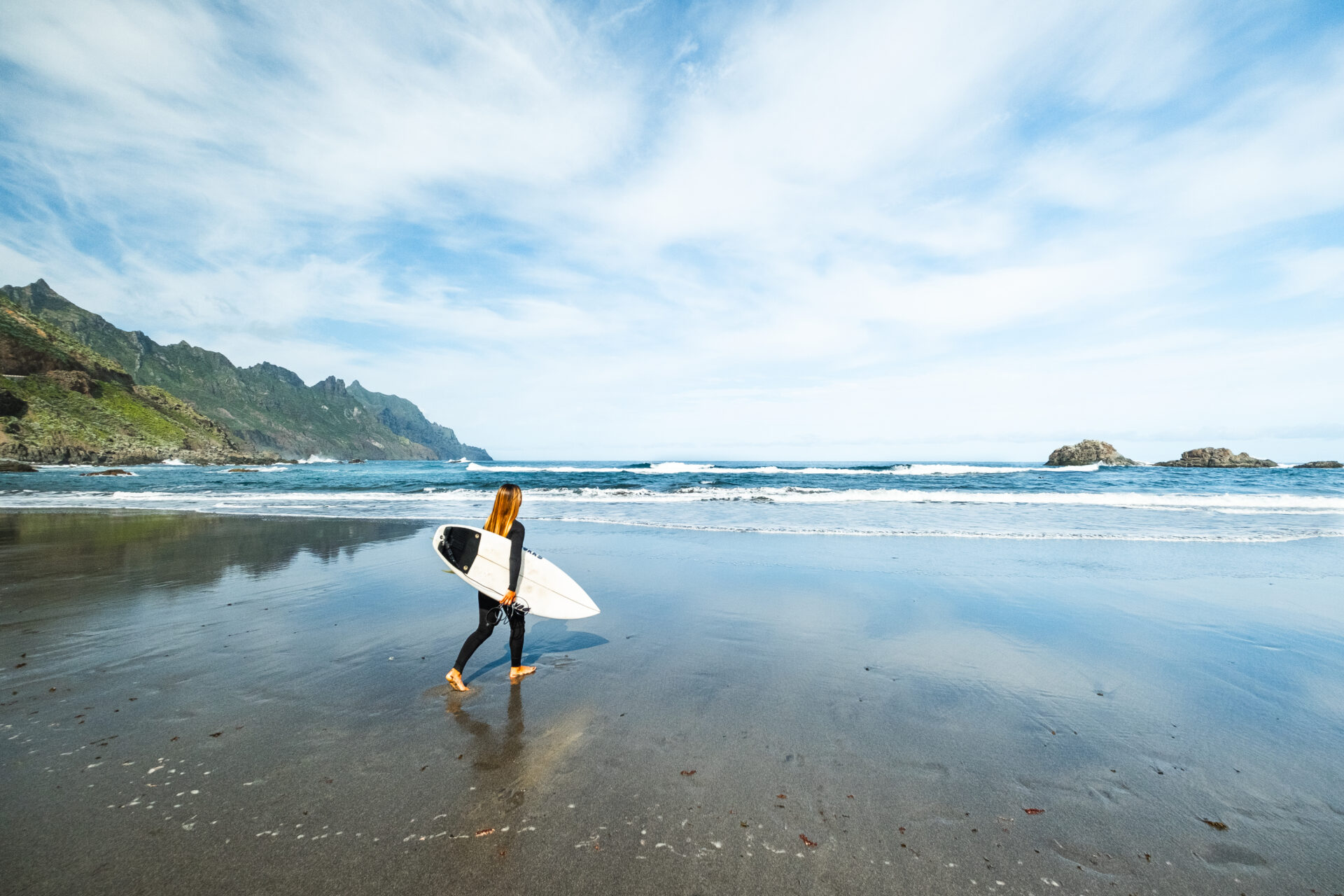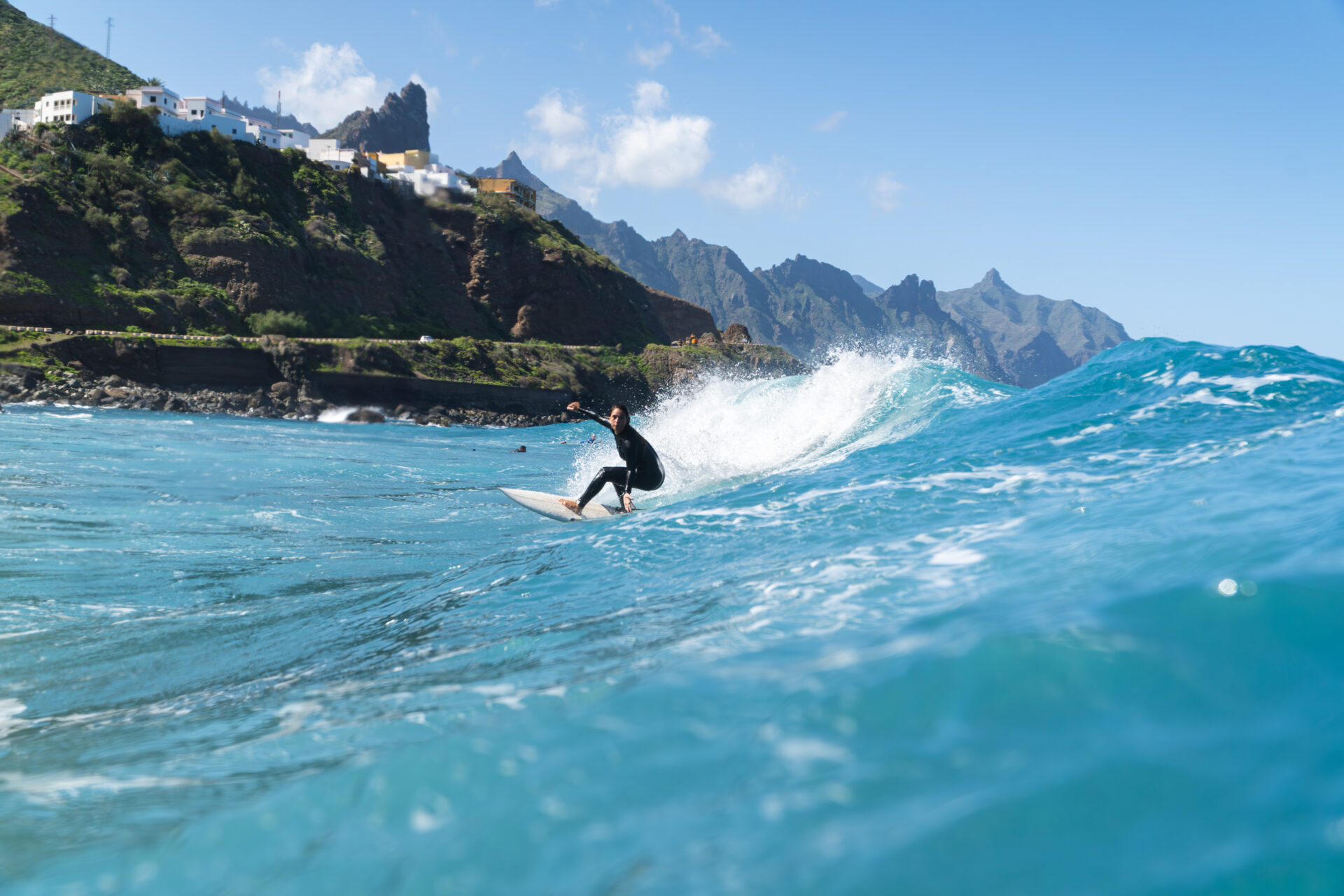
Tenerife is a paradise not only for sun and nature lovers, but also for surfers. Its warm weather all year round and varied coastline with waves for all levels have made the island an ideal destination for adrenaline seekers on its crystal-clear waters. A range of possibilities is open both for beginners who want to get started in this sport and more experienced surfers looking to push the limits of their skills.
Furthermore, one of the many perks of Tenerife’s climate is that the water is always warm! The water temperature ranges from 19 to 26 degrees, making it a favourite destination for many travellers who come to this experience-packed island. Hiking, cycling, diving, and, of course, surfing are just a few options among the wide variety of adventures Tenerife offers.

Everything you need to know to enjoy your surfing experience to the max.
Tenerife is the perfect place for all types of surfing. Thanks to the trade winds that arrive with summer and the low Atlantic pressures in winter, you’ll find numerous spots where you can ride the waves all year round.
The waves vary in difficulty and how they break depending on the bottom. The most accessible waves are ones that break over a sandy and rocky bottom. These are perfect for beginners or intermediate surfers. On the other hand, waves over volcanic reef bottoms are more challenging, so they are recommended only for surfers with more advanced technique and experience.
Get on the board and discover our top-tier waves
If Tenerife can boast anything, it’s the island’s wide range of waves; from Almáciga in Santa Cruz, with its combination of barrels and walls perfect for all levels, to Punta Blanca in Guía de Isora, which challenges even the most experienced surfers.
There are great spots all along the island’s coastline. There’s Bajamar, in El Lobo, ideal for beginners and intermediate surfers; and El Socorro, in Los Realejos, a spot that’s available year-round and renowned for its quality of right and left waves. For those seeking a more exclusive setting and who are at a more advanced level (intermediate to expert), La Derecha del Conquistador and Las Palmeras, both in Arona, and Las Conchas, in the Santiago del Teide community, offer tubular waves with volcanic reef bottoms. Similarly, La Caleta de Interián (in Los Silos) offers a unique environment for more experienced surfers, while the waves at Playa del Faro in El Porís de Abona, Playa Martiánez in Puerto de la Cruz, and El Socorro in Güímar are flexible options for surfers at various levels, especially beginner to intermediate.
Each of these beaches, with their sandy, pebbly, or rocky bottoms, and their specific wind and tide conditions, make Tenerife a must-see destination for travellers looking to surf in a natural setting unlike any other.

Two festivals you can’t miss
The Punta Blanca beach mentioned earlier is also a revered spot among advanced surfers. This enclave hosts one of the island’s most prominent surfing festivals: the Tenerife Puntablanca Young Series, an under-21 event that only takes place when the wave conditions are just right. There is no fixed date, because the sea sets the timing. In this competition, promising young surfers and bodyboarders are the focus of the event.
Similarly, Arona is the site of the Spring Surfest Las Americas Pro festival, an event that emerged from work between local, European and American collaborators. Surfers from all over the world have been able to experience the left-hand wave – the ‘Spanish Left’ – which appears in this area of volcanic seabed. Participants will be able to take part in various types of competitions across a variety of categories. Open to all ages.
Tips and equipment at your fingertips
Finally, we should highlight certain key safety considerations for surfing in Tenerife.
The strongest waves are found in the north and northwest of the island, while the southwest has less intense waves. However, this can vary depending on the time of year you visit, the strength and direction of the wind and ocean currents, the point of the tide, and the time of day. It’s essential for each surfer to assess their skill level and physical condition before getting in the water. Also, it is always advisable to go with a partner and to limit your sessions to no more than two hours to prevent fatigue and dehydration.
Likewise, surfers who carry their board everywhere and those who arrive on the island without equipment will be able to find a wide range of surf shops and schools on Tenerife. These establishments have everything you need to enjoy this sport. From boards that match every level to introductory courses for those who want to put on a wetsuit and dive into this experience on the waves. In addition, surf schools, such as the Fitenia Surf School Tenerife or Tenerife Surf Point, among others, offer specific programmes to perfect your technique and improve your performance in the water.
